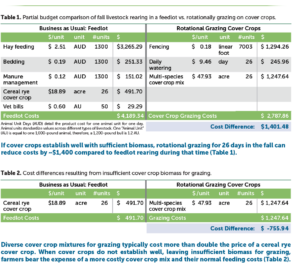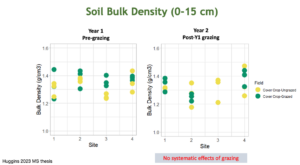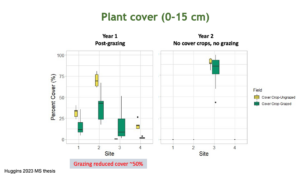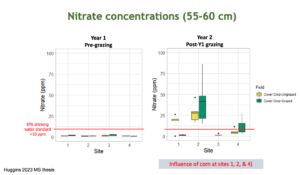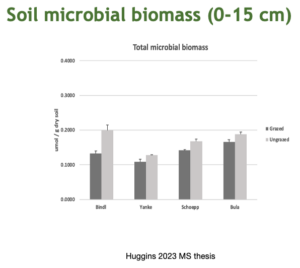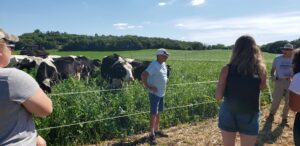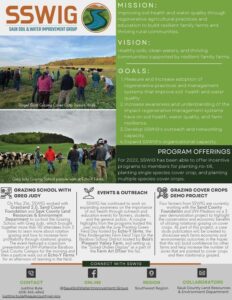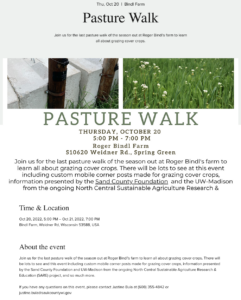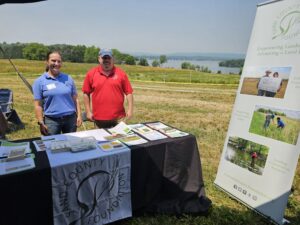Final report for LNC20-440
Project Information
Although Wisconsin cover crop acreage has been increasing, with a 10% jump in planted acres between 2012 to 2017 (USDA-NASS, 2019a), grazing cover crops is not yet common practice. Therefore, it presents an opportunity to introduce these combined management options onto livestock farms that currently use little or no rotational grazing or cover crops. Onto Greener Pastures with Rotational Grazing and Cover Crops is an education outreach project that will focus on demonstrating the value of cover crop grazing for soil health improvement, increased economic benefits, and nutrient runoff reduction.
Over the last 50 years, nitrate and phosphorus concentrations increased in many Midwest water bodies, specifically those in agricultural watersheds (EPA, 2017; WiDNR, 2017). Though Wisconsin’s short growing season does not provide an ideal window of opportunity to incorporate cover crops, there are cropping systems where it is conducive and critical to improving soil health and water quality. This collaboration will use the voice of champions to share feedback on grazing cover crops, to build confidence among other graziers. Our goal is to expand acreage in Wisconsin planted to cover crops and rotational grazing by providing conservation guidance and motivation to graziers on the combined use of these practices, resulting in a more resilient agricultural system.
Experienced graziers from Sauk Soil and Water Improvement Group (SSWIG) will partner with Sand County Foundation (SCF) and the University of Wisconsin (UW) to share their knowledge during field days and a webinar, document economic and environmental outcomes in two-page case-study publications, and provide a video interview. These resources will reach local (and national) graziers who have been interested in grazing cover crops but hesitant due to uncertainties about their efficacy in improving soil health, return on investment, and ability to establish cover crops. Our efforts will increase awareness, opportunity, and confidence in implementing cover crops with alternative grazing management using local demonstrations. Demonstrations will focus on documenting the benefit that livestock grazing has on the establishment and growth of cover crops, which is critical to overall system efficacy. Soil and environmental data will serve as critical calibration data for cover crops modules in agroecosystem simulation models in our USDA Sustainable Agricultural Systems Coordinated Agricultural Project (CAP) project, Grassland 2.0-An agroecological transformation plan for perennial grassland agriculture. Outcomes will include full agronomic accounting to capture improvements in farm finance stability, soil properties and environmental benefits generated with alternative grazing management systems.
Document full agronomic benefits of livestock grazing on growth and establishment of cover crops: We will demonstrate the value of cover crop grazing for soil health improvement, increased cost efficiency, and nutrient runoff reduction.
Overarching Learning Outcome: Through personal stories and modeled outputs, graziers understand benefits of rotational grazing cover crops on farm finances, agronomics, and ecosystem health.
Overarching Action Outcome: Farmers employ more cover crops and graziers incorporate alternative grazing management systems that include rotational grazing cover crops.
Over the last 50 years, nitrate and phosphorus concentrations have increased in many Wisconsin water bodies, and other Corn Belt states, specifically those in agricultural watersheds (Lathrop et al., 1998; EPA, 2017; WiDNR, 2017; Motew et al., 2019). Cover crops decrease the time that fields are left bare, potentially decreasing soil erosion and particulate nutrient loss in surface runoff and nitrate leaching losses (Snapp et al., 2005; Tonitto et al., 2006; Kaspar et al. 2007; Acuña et al., 2014). Though Wisconsin’s short growing season does not provide an ideal window of opportunity to incorporate cover crops, there are cropping systems where it is conducive and critical to improving soil health and water quality (Krueger et al., 2011; Wilson et al., 2014; Blanco-Canqui et al., 2015; Poeplau and Don, 2015; Cates and Jackson, 2018). For example, fields harvested earlier than conventional row crops such as those planted as winter wheat, hay, corn silage, or older alfalfa are optimal for cover crops – especially if they have been or are being used for livestock grazing. Although corn silage harvest date varies, once harvested all residue is removed from the field leaving several months of bare soil conditions, often with a manure application (Pratt et al., 2014). When well established, cover crops can armor the soil to reduce winter and spring erosion and nutrient loss, while improving soil health by maintaining living roots longer throughout the year (Martínez-García et al., 2018).
Overall soil health can also be enhanced through the adoption of improved grazing management practices, such as rotational grazing (Byrnes et al., 2018; Dahal et al., 2020). Water quality improves as the pasture vegetation becomes denser and the soil conditions improve (Vadas et al., 2015). Cover crop grazing can extend the grazing season by providing high quality forage in early spring and through late fall, reducing supplemental feed expenses for graziers. This financial piece is timely, as an increasing number of small dairy operations across the North Central Region have been struggling to survive. This year, for example, Michigan had one of the largest percentage drops in dairy farms (13%), while Wisconsin lost over 700 (6.5%) (USDA-NASS, 2019b). When properly established, grazing the forage can offset costs while improving the longer-term soil health to improve the system resiliency and increase future yield. Although cover crop acres in Wisconsin have been increasing, with a 10% jump in planted acres between 2012 to 2017 (USDA-NASS, 2019a), grazing cover crops is not yet common practice (Singer et al., 2007).
This presents an opportunity to introduce these combined management options onto livestock farms that currently use little or no rotational grazing and limited or no cover crops. Over the past several years, Sand County Foundation has engaged in conversation with graziers across Wisconsin who have inquired about grazing management and grazing cover crops. To address some of the current questions and needs of regional graziers, the project team will collaborate with graziers and grazing specialists to demonstrate the economic and environmental benefit of managed grazing systems that focus on building soil health.
Soil health principles include 1) Minimize Soil Disturbance, 2) Maximize Soil Cover, 3) Maximize Plant Diversity, 4) Maximize Presence of Living Plants/Roots and 5) Integrate Livestock. Often soil health projects neglect the principle of integrating livestock, so sample collection from the four demonstration farms will focus on documenting the benefit that livestock grazing has on both soil properties and growth and establishment of the cover crops. Additionally, this project will examine improving the economic and environmental viability of small livestock farms, both dairy and beef.
The 2019 growing season was noted as one of the most challenging planting seasons on record due to spring flooding and persistent rainfall across the North Central Region; with historic delays in corn and soybean plantings (Farm Bureau, 2019). Under current climate prediction models, soils within the region are expected to be exposed to drier conditions longer, as well as subjected to periods of more intense wetting and flooding (Melillo et al., 2014). Resilience is a measure of the soil’s ability to recover its structural form through natural processes following stresses such as raindrop impact, wetting/drying, or freezing/thawing. Soil structure, which is highly sensitive to human disturbance and management practices, is fundamental to controlling the soil health, productivity, and environmental quality of agricultural land (Singh et al., 2011).
Cover crop residues not only protect the soil surface from erosion during rainfall events, but the additional organic matter increases the soil’s water-holding capacity, improves infiltration, and reduces compaction. Increased organic matter stimulates macrofaunal activity, increasing soil aggregation and porosity (Blanco- Canqui and Jasa, 2019). Improved soil structure and porosity supports proper root growth and development, which is critical for nutrient uptake (Unger and Kaspar, 1994). Improved soil health can potentially reduce nutrient input costs, increase yield, and improve plant resilience. As the organic matter and residues are decomposed by soil microbial activity, natural organic chelate production increases. Chelates can tightly bind with cations to form an organic complex that can increase the plant availability of macro- and micro- nutrients (Clemens et al., 1990; Havlin et al., 1999).
Rotational grazing has been found to be the most profitable and environmentally beneficial system when compared against other dairy-based cropping systems (Posner et al., 1995; Dartt et al., 1999; Kriegl and McNair, 2005; Griffith and Posner, 2006; Chavas et al., 2009; Sanford et al., 2012; Hanson et al., 2013). Integrating rotational grazing with cover crops has the potential to be profitable, enhance production efficiency and improve water quality. There is a need, however, for research and training on the establishment of these management systems (Sulc and Tracy, 2007; Rojas-Downing et al., 2017).
Three factors that contribute to the decision-making process of farmers and ranchers on whether to adopt nutrient management and conservation practices into their farm operations include 1) information and awareness, 2) economic drivers, and 3) social norms (Liu, Bruins and Heberling, 2018). Farmers with high levels of self-efficacy in agricultural conservation are more likely to set conservation goals, adopt conservation practices, and adapt practices under changing conditions (Doll and Jackson et al., 2009; Bandura, 2012). Being aware of a conservation program or practice and having a positive experience or attitude associated with the program or practice is critical for acceptance and adoption (Prokopy, et al., 2019).
We focus this demonstration on spreading the voice of conservation champions through working with SSWIG graziers who already have positive experiences implementing cover crops but have not previously grazed their cover crops or would like to integrate the cover crop grazing into a new field. Farmers and ranchers are more likely to adopt practices if they have direct contact with local peers who can directly share soil and water conservation information (Prokopy et al., 2019). Science and technology can fail to effectively communicate or translate ecological outcomes in a way that is meaningful and usable to farmers (Pradhananga et al., 2017). Networking and knowledge sharing about conservation practices is a significant predictor on whether a farmer will adopt the conversation practices (Prokopy et al., 2008). When farmers and landowners are connected to community groups, they are also more likely to maintain conservation practices overtime (Prokopy et al., 2014). Therefore, farmer-to-farmer outreach is an effective method of information dissemination and field days have been identified as the quickest way to communicate new information on conservation practices (Murage et al., 2011).
The outreach throughout this three-year project will engage regional dairy and beef graziers. This will build awareness, opportunity, and comfort in implementing cover crops with alternative grazing management, which should help improve farmer profitability while enhancing water quality and reducing flooding potential across the region.
Abbreviated Citations
Acuña, J.C.M., and M.B. Villamil. 2014. Agronomy J. 106:860-870. Bandura, A. 2012. J. Management 38(1):9–44.
Blanco-Canqui et al., 2015. Agronomy J. 107:2449-2474. Blanco-Canqui, H., and P.J. Jasa. 2019. SSSAJ 83:1181–1187. Byrnes et al., 2018. J. Environmental Quality 47:758-765.
Cates, A.M., and R.D. Jackson. 2018. Agronomy J. 110:1-9. Chavas et al., 2009. Agronomy J. 101:288-295.
Dahal et al., 2020. Sustainability 12.
Dartt et al., 1999. J. Dairy Science 82:2412-2420. Doll, J. E., and R.D. Jackson. 2009. JSWC 64:276-285.
Clemens et al., 1990. Fertilizer Research 25:127-131.
EPA. 2017. Mississippi River/Gulf of Mexico Watershed Nutrient Task Force Report to Congress. Washington, D.C.
Farm Bureau (2019) https://www.fb.org/market-intel/crop-planting-delaysreach- historic-levels- resulting-in-high-levels-of-unce.
Good et al., 2018. SnapPlus 18.0. www.snapplus.wisc.edu.
Griffith, K., and J. Posner. 2006. Comparing upper midwestern farming systems. UW-Madison. Hanson et al., 2013. J. Dairy Science 96:1894-1904.
Havlin et al., 1999. Soil Fertility and Fertilizers, 6th Edition. Prentice-Hall, Inc. Kaspar et al., 2007. J Environ Qual 36:1503-1511.
Kriegl, T., and R. McNair. 2005. Pastures of plenty: Financial performance of Wisconsin grazing dairy farms. Krueger et al., 2011. Agronomy J. 103:316.
Kucharik, C.J. 2003. Earth Interactions 7:1-33.
Lathrop et al., 1998. Canadian J. Fish & Aquatic Science 55:1169-1178. Liu et al., 2018. Sustainability 10(2):432.
Luloff et al., 2011. Ecosystem Science and Management 24(12):1345-1353. Martínez-García et al., 2018. Agriculture, Ecosystems & Environment 263:7-17.
Melillo et al., (eds). 2014. Climate change impacts in the United States: The Third National Climate Assessment. U.S. Global change Research Program. Government Printing: Washington D.C
Moore, J. E., and D. J. Undersander. 2002. in Proc. Florida Ruminant Nutrition Symposium,UF- Gainesville. Motew et al., 2019. Science of The Total Environment 693:133484.
Oates et al., 2017. J. Visualized Experiments 125:e55310.
Poeplau, C., and A. Don. 2015. Agriculture, Ecosystems & Environment 200:33-41. Posner et al., 1995. J. Alternative Agriculture 10:98–106.
Pradhananga et al., 2017. JSWC 72(6):639-649. Pratt et al., 2014. Agricultural Systems 130:67-76. Prokopy et al., 2008. JSWC 63(5):300-311.
Prokopy et al., 2019. JSWC 74(5):520-534.
Prokopy et al., 2014. Adoption of agricultural conservation practices: insights from research and practice. Purdue Extension. FNR-488-W.
Rojas-Downing et al., 2017. Agricultural Systems 153:157-171.
Sanford et al., 2012. Agriculture, Ecosystems & Environment 162:68-76. Schipanski et al., 2014. Agricultural Systems 125:12-22.
Singer et al., 2007. JSWC 62:353-358.
Singh et al., (eds.). 2011. Soil Health and Climate Change, Soil Biology 29, Springer-Verlag Berlin Heidelberg.
Snapp et al., 2005. Agronomy J. 97:322-332.
Sulc, R.M., and B.F. Tracy. 2007. Agronomy J. 99:335–345.
Tayyebi et al., 2016. Computers and Electronics in Agriculture 121:108-121. Tonitto et al., 2006. Agriculture, Ecosystems & Environment 112:58-72.
Unger, P.W. and T.C. Kaspar. 1994. Agronomy J. 86:759-766. USDA-NASS. 2019a. Census of Agriculture. Washington, D.C.
USDA-NASS. 2019b. Wisconsin 2019 Agricultural Statistics. Madison, Wisconsin. Vadas et al., 2015. Agriculture, Ecosystems & Environment 199:124-131.
WI-DNR. 2017. Wisconsin’s Nutrient Reduction Strategy 2015-2016. Madison, Wisconsin
Wilson et al., 2014. JSWC 69:67A-72A
Cooperators
Research
Rotational grazing with cover crops will improve livestock and soil health, reduce nutrient leaching/runoff losses, and reduce inputs costs for the project's collaborating graziers.
Data collected during this demonstration project will be used to:
- Estimate how rotational grazing of cover crops affects cover crop growth, forage availability, and soil health.
- Estimate annualized costs of rotational grazing cover crops.
- Incorporate environmental, agronomic, and financial aspects of cover crop grazing into agroecosystem simulation models.
- Engage farmers of the North Central US to consider incorporating cover crops and re-integrating livestock into annual grain production systems.
Site Selection
This project is unique because we are combining outreach and demonstration with our collaboration with four graziers from the Sauk Soil and Water Improvement farmer-led watershed group (SSWIG) to estimate management specific return-on-investment values, generate erosion and nutrient losses, and collect soil health and cover crop yield data for each demonstration farm. SSWIG is comprised of more than 15 farmers located in the flood-prone area of Sauk and Columbia Counties in southern Wisconsin. The group met for the first time in 2019 and applied for a State of Wisconsin Producer-Led Watershed Protection grant, which they were awarded. One of SSWIG’s primary goals is to increase water infiltration within the watershed.
The demonstration will include a collaboration with four (4) farmers from SSWIG, field selection will be based on identifying areas that were not previously rotationally grazed with cover crops, feasible to create paddocks for rotational grazing, and manageable based on visual assessment of slope, aspect, landscape position, and hydrology. To be practical, implemented systems will not be prescriptive but will vary farm-to-farm. Demonstration fields used at each location will be based on what is conducive to the realistic management applied by each grazier depending on specific needs and capabilities. Each farm will change their management of one field to cover crop grazing and leave a control field that continues under their current management (w/out grazed cover crops). Sand County Foundation will work with each of the four farms to support their operations, both financially, as they adopt changes, and technically, to implement the cover crops into their rotational grazing management. An example provided by each grazier is summarized below.
Ron Schoepp (Schoepp Farms) will rotationally graze cover crops and corn stalks following the harvest of corn and winter wheat crops. Parts of the 19-acre field will be excluded from the grazed area, with both areas sampled for soil health parameters to quantify the difference caused by grazing. Ron has used rye as a cover crops after corn and soybeans for years. To extend the grazing season, livestock graze the corn stalks after grain harvest. He wants to demonstrate how corn stalks and cover crops can add more feed while enhancing the health of his livestock and soil. Ron plans to interseed a cover crop mix between corn rows. This should result in producing more biomass for grazing after the corn is harvested. The demonstration field has been no-tilled for over 20 years and was in soybeans last year. After harvest, wheat was no-till planted. The wheat was harvested in July 2021 and the cover crops were no-till planted early August, with hope to start grazing dairy heifers on the field in October or November.
Darren Yanke (Echo-Y Farms) will harvest winter wheat in late July and early August. He will plant the cover crop mix after harvest and proceed to put a temporary fence around the 80-acre field. Holstein heifers and/or grassfed beef will start grazing the cover crop weather permitting in October and until December, depending on the weather. The cattle will move to a new paddock every 1 or 2 days.
Roger Bindl's fields are currently planted in a corn/soybean/winter wheat rotation, with the demonstration starting in a winter wheat year. Once the wheat is harvested in August, a diverse mix of cover crop species will be planted with the intent to graze cattle in the fall once fully established. Fields planted with the cover crop mix will be grazed in the fall and monitored closely to assess the effect of the cover crop and grazing treatment. A portion of the field will be fenced off from grazing cattle to serve as a control for the study.
Ron Bula wants to see how his production changes and what economic benefits he can achieve by focusing on cattle grazing and adopting a mixture of cover crops. Similar to relay cropping methods, a cover crop mix will be planted, grazed by cattle, then no-till seeded with the next mix using a three-stage rotation: spring, summer, and fall. Ron will maintain one of his existing fields in the pre-existing crop/forage rotation without grazing. Another field will be planted with the three-stage cover crop rotation, with grazing incorporated.
Grazier Interviews
In Spring 2021, Sand County Foundation met with the four SSWIG graziers to conduct management interviews to thoroughly record their agronomic management practices. This information was used to develop a demonstration plan, but will also be used to quantify input costs, detail system management specifics, and develop a plan for grazing and cover crop termination.
The information was used to generate the four farmer profiles, which will be extended upon project completion into case-study publications. The interview included questions to understand motivations for adopting rotation grazing of cover crops.
In addition to the interview questions, agronomic data collected by the University of Wisconsin and SCF will be used as input data to estimate the economics of grazing cover crops and model environmental runoff for the four demonstration fields. For example, graziers will track grazing livestock numbers and dates so that financial savings can be calculated. Timing of planting and terminating the cover crop will be monitored. All data collected over the 2-year period will be used to help develop costs projections including seed, site preparation, fencing, fertilizer, establishment, and maintenance costs.
A skeleton for the agronomic table has been developed initiate the cost benefit analysis. UW and SCF staff have already met with two farmers individually to compile data, and plans are being made to meet with the other two farmers to obtain site specific data.
Partial Budget
Partial budgeting is a planning tool that can help a farm manager understand how a decision will affect the profitability of the farm enterprise. It compares the whole-farm costs and benefits of implementing alternative management compared to a farm’s “business as usual” or normal operations. Some examples of alternative management include raising your own replacement heifers, making capital improvements, or purchasing equipment. Partial budgets consider:
1. Increased returns/revenues
2. Eliminated or reduced costs
3. Additional or increased costs
4. Eliminated or reduced returns/revenues
We created a partial budget to compare rotational grazing of cover crops to raising livestock in a feedlot using 2023 costs from Sauk County, Wisconsin. Using average field size and “typical” management of the region, we estimated costs associated with grazing 50 head of beef cattle in a 26-acre row crop field on cover crop forage for 26 days in the fall. We assumed that a farmer would normally plant a cereal rye cover crop when not grazing and a diverse cover crop mixture when grazing. Feedlot costs included hay feed, straw bedding, manure management, and vet bills, while grazing costs included temporary electric fencing supplies (annualized over 20 years).
Environmental Parameters
University of Wisconsin began to collect basic soil health and nutrient parameters during spring 2021. Cover crop and forage biomass data from each paired demonstration field and reference site were collected before and after grazing. In addition to measuring the crops and collecting samples, the Canopeo app was used to record percent ground cover.
Aboveground biomass samples of the overwintered cover crops were collected in April 2022. At site three, samples were only collected in the treatment field for year two.
Aboveground biomass samples were collected pre and post grazing at site three for three grazing events during the growing season. At site one in year two, no biomass samples were collected as the cover crop growth was negligible and grazing did not occur. At sites two and four pre grazing was collected while post grazing was not, due to snow and no grazing at site four. Corn residue height and biomass was collected separately from the cover crop biomass but with the same method of cutting to four inches within the quadrant.
Aboveground biomass samples from year one were ground using a downdraft table. The next step is to grind the year one and two biomass using a Udy cyclone mill and run through near infrared spectrometer (NIR) to obtain relative feed quality (RFQ).
Soil samples were collected by the UW graduate student in fall 2021, prior to the ground freezing. Total carbon, total nitrogen, and water stable aggregate analyses are in progress.
Bulk density samples were collected at each site and are being analyzed at the UW lab.
Saturo sampling for infiltration rate was attempted several times during fall 2021 period, but the instrument was malfunctioning and has not continued.
The year one deep cores were processed. The height of the soil was recorded and determined that the 50 to 55-cm increment will be removed using a bandsaw to be sent to the rock river lab for nitrate and ammonium analysis. This left two sections for each core 0-55cm and 60cm - end (100cm max). Year one deep cores were stored in the freezer until they were moved to the fridge to thaw for processing. To process the deep cores, the deep core in the sleeve was laid on a table and a sleeve cutter was slid down the side of the sleeve length wise and then the core was rotated to slide the cutter down the other side of the sleeve to access the soil core intact. A meter stick was used to measure out 0-15cm, 15-30, and 30-55cm depth segments. Each depth segment was placed into a prelabeled Ziploc bag. The bottom section of the core, 60cm-end, was also laid out on the table in the sleeve and measured with a meter stick to record to total height of the core and then the sleeve cutter was used to remove the soil and place into a prelabeled Ziploc bag and were processed the same as the other depth segments. The soil was then mixed inside the Ziploc bag. For soil moisture: After mixing the soil in the Ziploc bag, roughly 20g was weighed out onto a paper plate for soil moisture analysis and put into the 60 °C drying oven for 48 hours. After 48 hours the subsample’s weight was recorded before placing it into the 105 °C drying oven for 24 hours. The subsample was then removed from the 105 °C drying oven, weighed, and sieved to 2mm for any gravel. The sieves were cleaned with 70% ethanol between samples. If the subsample had gravel, it’s weight was recorded. The weights were used to calculate gravimetric water content. After the soil moisture subsample was removed from the Ziploc bag, the rest of the soil was sieved to 2mm, removing all gravel and roots from the sample. The wet weight of the gravel and roots was recorded. Of the sieved soil a subsample of roughly 20g was removed and placed on a paper plate to be air dried for POX-C analysis. The rest of the sieved soil was transferred to a paper bag and placed into the 60 °C drying oven to dry out completely. Once dried, a subsample (~1g) was collected into a small vial and then given to the lab to run through the Thermo FlashEA1112 for total carbon and total nitrogen analysis.
The deep cores sampling method differed in year two to better accommodate removing the subsamples for nitrate and ammonium analysis. This was remedied by not using a plastic sleeve to line the core and instead removing the core from the metal core cylinder immediately into a trough and separating each depth segment into a prelabeled Ziploc bag in the field. Once back to the research station the 0-15cm depth segment was weighed and a subsample was taken to be analyzed for nitrate and ammonium in addition to the 55-60cm depth segment. All samples and subsamples were then placed into the freezer until further processing. The samples for nitrate and ammonium analysis, once frozen, were transported to rock river laboratory to be analyzed.
Processing year two deep core samples has begun following a similar protocol of moving the already separated depth segments to the fridge to thaw, taking soil moisture grab samples, sieving to 2 mm and then air drying the POX-C subsample and drying in the 60°C oven, the rest of the sieved sample in a paper bag.
Water Quality Benefits
To estimate phosphorus loss in runoff, SCF has been entering agronomic data collected during the grazier interviews into the Soil Nutrient Application Planner (SnapPlus) to provide a before and after runoff comparison of sediment and phosphorus loss from each of the four paired fields (Good et al., 2018). SnapPlus is an agricultural nutrient management planning (NMP) tool developed by the University of Wisconsin - Madison for use in Wisconsin. SnapPlus has been updated over the years to be used as an agricultural conservation compliance tool through the use of a soil loss calculation output and a Phosphorus Index (PI) calculation output that indicates non-compliance with the Wisconsin Phosphorus Rule.
Grassland Model Improvement
Soil and environmental data collected from these demonstrations will serve as critical calibration data for cover crops modules in agroecosystem simulation models being improved in our USDA Sustainable Agricultural Systems CAP project, Grassland 2.0-An agroecological transformation plan for perennial grassland agriculture. These models include SnapPlus (widely used in Wisconsin for farm-gate nutrient management plans; Good et al., 2018), Agro-IBIS (a process-based simulation model that predicts C, N, P, and H2O flows; Kucharik, 2003), and SmartScapeTM (a landscape-level decision support tool used to understand how altering land use and land cover affects a range of ecosystem service outcomes; Tayyebi et al., 2016). The farm finance information will help populate the ‘farm-gate financials’ module of SmartScape. As part of the Grassland 2.0 project, C, N, and P losses estimated from these farm fields with and without cover crops will be used to calibrate newly parameterized SnapPlus, Agro-IBIS, and SmartScape models. The graduate student research assistant for this SARE project will work closely with the modelers from SCF and Grassland 2.0 in this effort.
Outreach
Working closely with the collaborating SSWIG graziers, information gathered through their interviews, cover crop and forage biomass sampling, soil health parameter analyses, rate of return estimation and SnapPlus modeling will be integrated into four unique case-study publications.
To ensure that the project outputs are practical, actionable, and address current questions and areas of concern, the team has been collaborating with Serge Koenig and Justine Bula (Sauk County, Department of Land & Water) and Todd Reitmann (Columbia County, Department of Land & Water).
As part of Grassland 2.0, the models described previously will be used in numerous stakeholder engagement events. The primary importance of the model development is how we will use them in stakeholder engagement over the next 5 years in Grassland 2.0 Learning Hubs, which are iterative workshops convened at several local Wisconsin watersheds, the 4-state Driftless Area, and the 11-state North Central Region.
SnapPlus Phosphorus Runoff Assessment
SnapPlus has the State of Wisconsin water quality compliance calculations incorporated for assessment of farm field phosphorus and sediment loss. This is provided for both regulatory and general environmental impact assessment purposes. For this project assessment, the particular outputs used are the Phosphorus Trade Pounds (PTP) and Sediment Trade Pounds (STP). The PTP output is total pounds of phosphorus lost from the entire field under the defined management. The STP output is total tons of sediment lost from the entire field under the defined management. Although SnapPlus does not currently offer a rotational grazing of cover crop management option, we simulated the baseline condition in the fields as "crop only" and then compared it to the output from the "crop with cover crop" scenario.
Three of the four collaborating farms involved in the field data collection for the project were modeled in SnapPlus. These three farms following a consistent design, adding a cover crop mixture into their existing row cropping system. The cover crops would then be grazed after the row crop was harvest. The fourth farm was utilizing a cover crop relay grazing system that could not adequately be simulated in SnapPlus.
Bindl Farm
The Bindl study area is 4.4 acres (silt loam soil with Bray-1 P 98 ppm), with a 4% slope and field slope length modeled 0-300 feet. The field is in a winter wheat (2021 crop season), corn (2022 crop season), and soybean (2023 crop season) rotation. A cocktail cover crop mix was seeded after winter wheat harvest (entered as input to SnapPlus as annual cover crop after winter wheat) and grazed in the fall by 20 dairy heifers (weighing approximately 750 pounds each) using an annual grazing manure application rate of one ton per acre. Cover crops in 2022 were interseeded into corn in early stages and was entered as input to SnapPlus as an annual grain cover crop in a corn grain system. The cover crop and corn stalks were grazed in fall by 20 dairy heifers (weighing approximately 750 pounds each) using an annual grazing manure application rate of one ton per acre. Grazing will not take place following soybeans in fall 2023, as the field will be planted to winter wheat for the next year’s cash crop.
| Bindl SnapPlus Output | ||||||
| Treatment |
2021 PTP- WW |
2022 PTP- Corn |
2023 PTP- Soybean |
2021 STP- WW |
2022 STP- Corn |
2023 STP- Soybean |
| Modeled Projected Yield (BU/Acre) | 61-80 | 191-210 | 55-65 | 61-80 | 191-210 | 55-65 |
| Crop alone (Baseline) | 4.2 | 6.8 | 4.4 | 0.49 | 1.07 | 0.15 |
| Crop & Cover Crop | 4.2 | 6.4 | 4.6 | 0.48 | 0.99 | 0.17 |
| Crop & Cover Crop, Grazed | 4.2 | 5.8 | 4.9 | 0.57 | 0.90 | 0.24 |
SnapPlus results indicated an increased loss of phosphorus (P) and sediment during the corn year, compared to winter wheat (WW) or soybean. The addition of cover crops had only negligible effects on P loss, but did reduce sediment loss from the corn year. When the cover crop scenario has grazing incorporated in the outputs, the P and sediment loss during the corn year decreased; though the corn season still modeled higher losses compared to the WW and soybean years.
Schoepp Farm
The Schoepp Farm study area is 18 acres (silt loam soil with Bray-1 P 10 ppm), with a 16% slope and field slope length modeled 300-1000 feet. It is in a winter wheat (2021 crop season), corn (2022 crop season), and soybean (2023 crop season) rotation. A cocktail cover crop mix was seeded after winter wheat harvest (entered as input to SnapPlus as annual cover crop after winter wheat) and grazed in the fall by 50 dairy heifers (weighing approximately 1400 pounds each) using an annual grazing manure application rate of three ton per acre. Cover crops in 2022 were planned to be interseeded into early stage corn in, but the buckwheat planted the previous year had a dense stand that of volunteer buckwheat. This was entered as input to SnapPlus as an annual grain cover crop in a corn grain system. The cover crop and corn stalks were planned to be grazed in fall by 50 dairy heifers (weighing approximately 1400 pounds each) using an annual grazing manure application rate of three ton per acre. Although this assessment included grazing after corn in fall 2022, in reality, fall grazing did not occur as the cover crop stand was buried under snow before grazing could occur. Grazing in spring 2023 will be attempted based on weather conditions. However, even with this change in the grazing schedule, the way it is entered into SnapPlus would not change due to the limited options for grazing management. Grazing will not occur after soybean harvest, as the field will be planted to winter wheat for the next year’s cash crop.
| Schoepp SnapPlus Output | ||||||
| Treatment |
2021 PTP- WW |
2022 PTP- Corn |
2023 PTP- Soybean |
2021 STP- WW |
2022 STP- Corn |
2023 STP- Soybean |
| Modeled Projected Yield (BU/Acre) | 61-80 | 191-210 | 55-65 | 61-80 | 191-210 | 55-65 |
| Crop alone (Baseline) | 3.2 | 5.2 | 3.0 | 0.64 | 0.60 | 0.50 |
| Crop & Cover Crop | 3.1 | 4.4 | 3.1 | 0.61 | 0.43 | 0.41 |
| Crop & Cover Crop, Grazed | 3.6 | 5.1 | 3.5 | 0.59 | 0.41 | 0.51 |
SnapPlus results indicated an increased loss of phosphorus (P) during the corn year, compared to winter wheat (WW) or soybean. This was for all three scenarios (adding a cover and a grazed cover). The addition of cover crops reduced P and sediment loss from the corn years. Sediment loss was also reduced during the soybean year by adding cover crops. When the cover crop scenario has grazing incorporated in the outputs, the P loss increased for all crop years, likely due to the modeled increase in manure P.
Echo-Y Farm
The Echo-Y (Yanke) study area is 50 acres (silt loam soil with Bray-1 P 40 ppm), with a 16% slope and field slope length modeled 1001-5000) feet. It is in a winter wheat (2021 crop season), corn (2022 crop season), and soybean (2023 crop season) rotation. A cocktail cover crop mix was seeded after winter wheat harvest (entered as input to SnapPlus as annual cover crop after winter wheat) and grazed in the fall by 50 dairy heifers (weighing approximately 1400 pounds each) using an annual grazing manure application rate of one ton per acre. Cover crops in 2022 were planned to be interseeded into early stage corn in, but the buckwheat planted the previous year had a dense stand that of volunteer buckwheat. This was entered as input to SnapPlus as an annual grain cover crop in a corn grain system. The cover crop and corn stalks were planned to be grazed in fall by 50 dairy heifers (weighing approximately 1400 pounds each) using an annual grazing manure application rate of one ton per acre. In reality, 2022 fall grazing of cover crops did not occur, as the cover crop stand was drowned out by water hemp. A fall rye cover crop was planted and may be grazed in spring 2023. However, even with the change in this cover crop and grazing schedule, the way it is entered into SnapPlus would not change due to the limited scenario options for grazing cover crops.
| Echo-Y SnapPlus Output | ||||||
| Treatment |
2021 PTP- WW |
2022 PTP- Corn |
2023 PTP- Soybean |
2021 STP- WW |
2022 STP- Corn |
2023 STP- Soybean |
| Modeled Projected Yield (BU/Acre) | 101-120 | 211-230 | 66-75 | 101-120 | 211-230 | 66-75 |
| Crop alone (Baseline) | 34.0 | 21.9 | 23.9 | 0.55 | 0.55 | 0.34 |
| Crop & Cover Crop | 53.9 | 53.9 | 32.5 | 1.01 | 0.55 | 0.34 |
| Crop & Cover Crop, Grazed | 53.9 | 57.1 | 32.8 | 3.47 | 4.06 | 1.03 |
Results from Echo-Y Farm were quite different from the other two modeled farms due to the projected crop yield. SnapPlus considered nutrient uptake from the projected crop yield into the potential P loss (since it is a mass balance nutrient balance tool). Since more P is being taken up by the crops, the potential P loss increases when a cover crop is added to the scenario. This is due to the expectation that the dissolved P from the decomposed cover crop will be lost. This can be observed by reviewing the sediment loss following WW with a cover crop, which is twice the loss from the WW alone. The output from the grazed cover crop scenario increases three to eight times!
From our assessment results, we suggest a more robust tool be used to assess the water quality benefits of grazing management. The tool should incorporate scenarios that are more consistent with the practices progressive graziers are adopting.
Agro-IBIS Model Improvement
We have modified the Agro-IBIS model to simulate traditional continuous corn and corn-soybean rotation systems that incorporate winter wheat planted after harvest each year as a proxy for winter cereal cover crops. The simulated biomass results come into agreement with observed data from the Arlington, WI, region (continuous corn system: R2 ≈ 0.56), which highlights the ability of Agro-IBIS to predict the growth and development of winter cereal cover crops. We are currently preparing a scientific manuscript that will provide a comprehensive description of our validation process for incorporating winter cereal cover crops into Agro-IBIS, which will be submitted to Agricultural Systems international journal. This manuscript will offer detailed insights into our methods and findings and will be the foundation for future work regarding the challenges of cover crops adoption in the Midwest, as well as their impacts on ecosystem service tradeoffs and synergies. For example, preliminary results of our simulations have shown that cover crops can grow in certain years with an early enough planting window, but when they are planted too late in fall, they have much less success.
Agronomics
See the attached product hand-out/fact sheet for more specific results from the four grazier case-studies.
SnapPlus Recommendations to Incorporate Rotational Grazing
Since SnapPlus is a nutrient management planning tool, it requires detailed agronomic inputs. This particular aspect makes it useful for agricultural compliance work, but our assessment found it is not robust enough to adequately assess the benefits of grazing management. SnapPlus was primarily designed to evaluate standard row cropping systems and dairy operations. Updates have occurred to incorporate new management including cover crop scenarios, but inputs for grazing operations are limited to manure calculations. There is an option to list a field as pasture to estimate the perennial grass effect on environmental outcomes, but there is not an option to assess the effect of grazing the cover crops or looking at alternative perennial pasture systems. As a result, all grazing systems report added nutrient input due to the manure calculated based on livestock in the field; in other words, adding livestock to a field will always result in SnapPlus outputs indicating an increase of P loss. Additionally, planting cover crops is only modeled after the commodity crop is harvested (or through aerial seeding); SnapPlus does not currently allow for interseeding into corn or other crops. Across the Midwest, cover crops are more frequently being interseeded into standing corn, which increases the establishment rate, biomass production, and ability to protect the surface soil during fall runoff events.
Soil and Plant Analysis
*Keep in mind, all samples are based on one year of data. Further sample collection would be necessary to adequately document change.
Soil bulk density baseline values from year one plotted with year two. There is no visible change with the addition of grazing. This means there is not an increase or decrease in compaction from the livestock grazing hoof action.
After one season of grazing, plant biomass is reduced by approximately 50% cover.
According to the Wisconsin DNR, a non-polluted ecosystem will have nitrate concentrations around 2 ppm (and farms, in general, are considered polluted). Our four sites all had Nitrate concentrations at 2 ppm in Year 1, which indicates that the grazing systems that they are managing are efficient and not contributing to a "polluted" ecosystem. However, in Year 2 the values drastically increase suggesting that the corn year has more impact on Nitrate concentrations than does the grazing.
When comparing our results with the outcomes of a study looking at microbial biomass in agriculture versus prairie systems 9Herzberger et al., 2014), the total microbial biomass in our four sites compare favorably with corn (perhaps slightly higher), but is much less than established prairies in southern Wisconsin.
Overall, cover crops seem to be adding benefits to the soil while management seems to impact the values (nitrate and ammonium) more than the grazing impacts (bulk density and POXc).
Agronomics
Despite issues with cover crop establishment after corn, all four graziers are excited to continue grazing cover crops. They found that an extended grazing season and reduced feed costs overcame the risks of needing a backup plan when the cover crop did not produce enough biomass to graze.
Overall, the lessons learned were:
- Cover crops after wheat (Year 1) allowed plenty of biomass accumulation before grazing, leading to positive economic benefits.
- Most farmers could not graze after corn (Year 2) because of a shortened season and insufficient biomass.
- Using temporary electric fencing and portable stock tanks reduces the upfront costs of fencing and water infrastructure.
- Grazing a row crop field close to the farm can save on transportation and fence battery costs, yet our case study farm still saved on feed costs grazing a field three miles away.
Considerations for farmers interested in rotational grazing with cover crops:
- Savings vary year-to-year based on annual fluctuations in the market.
- Reliable cover crop growth affects the economic and environmental benefits of grazing cover crops.
- Proper cover crop establishment is essential to having enough biomass to graze, and annual weather conditions may create additional challenges.
- Farmers should aim to graze about half of the cover crop biomass, leaving significant residual biomass for water quality and soil health benefits.
In summary, our four case-studies suggest that integrating rotational grazing of cover crops into row crop systems can help reduce the environmental implications of traditional row crop systems (i.e., reduce nitrate leaching, increase soil cover) while reducing the expenses incurred by livestock farmers.
Education
The four farmer collaborators are early adopters and all part of a farmer-led group, Sauk Soil and Water Improvement Group (SSWIG). They have experience hosting field days and pasture walks on their farms.
By engaging experienced 'conservation champions' in the demonstration, we can collect data to answers their specific questions regarding the economic, environmental, and agronomic benefits of rotational grazing with cover crops to improve their confidence as they promote their management approach. The goal is to empower them to share their lessons learned with other farmers within their watershed group and across the north-central region.
The project team will share information about the conservation management and resulting outcomes with farmers, Certified Crop Advisors, and other conservation professionals at field days and through webinars.
Educational outputs include:
- Develop four case studies, journal article, video, and webinar to articulate personal experiences and impacts of grazing cover crops.
- Complete a field-day and collaborate in additional partner outreach events.
- Integrate soil and environmental data from demonstration farms into agroecosystem simulation models.
Project Activities
Educational & Outreach Activities
Participation summary:
At the launch of the grant period, Sand County Foundation developed a press release announcing the project award. It was shared by Agri-view on April 5, 2021 and Country Today on October 9, 2020. The project was highlighted on Sand County Foundation's Facebook page on March 23, June 4th (Dairy Month), June 28, and September 24, 2021.
A project website was created in the Fall 2020. At the end of the project grant cycle (Spring 2024), there have been 374 unique viewers.
Four farmer profiles were developed in Fall 2021, to showcase each collaborator's farm management and to summarized the demonstration details for each site (see above under Project Activities). These profiles will be expanded throughout the project to build in a case study with data.
A project kick-off meeting was held in November 2020 to narrow down field locations and demonstration objectives. During this meeting it was determined that two of the original proposed site collaborators would be changed in order to ensure that the project goals aligned with the goals of the collaborating farmers.
A project advisory meeting was hosted by the project team (SCF and UW) at the Sauk County Land Resources and Environment office on January 13, 2022. Preliminary data were shared and the 2022 field season was discussed. The meeting was attended by the Farmer Collaborators, Justine Bula (Education Coordinator, Sauk County Dept. of Land Resources & Environment), Patrick Bula (Soil Conservationist, NRCS-Baraboo), Serge Koenig (Conservation Technician, Sauk County Dept. of Land Resources & Environment) and Todd Reitmann (Senior Resource Management Specialist, Columbia County Dept. of Land & Water).
To initiate the spring 2022 sampling season, Sand County Foundation hosted a project research team meeting on April 5, 2022. Following up on that call, the next week (April 13, 2022) the team met virtually with the four collaborating graziers to discuss their 2022 cropping and grazing plans.
Sand County Foundation supported/participated in Sauk County Land and Water Department's Greg Judy Grazing School on May 21, 2022. It was held at the UW-Baraboo campus with a field tour at the Echo-Y farm. Nearly 200 farmers were present and 50 conservation professionals.
Sand County Foundation promoted the SARE grazing project with a booth and short presentation at the Conservation by the Lake event at one of our collaborating sites, Schoepp Family Farm on August 4, 2022. Approximately 70 farmers and 15 conservation professionals attended.
University of Wisconsin graduate student, Carly Huggins presented at a 2022 summer science series hosted by a Madison, Wisconsin based local eatery and cidery. It is open to the public, and she discussed the project and her role within the project in a storytelling format.
Sand County Foundation hosted approximately eight SARE board members for a tour at farmer Darren Yanke's farm on August 16, 2022.
On August 28, 2022 the research team had a check in discussion to outline changes that one farmer collaborator made on their demonstration field.
On October 6, 2022, agronomic data was collected through an in-person farm meeting with Roger Bindl and Darren Yanke.
Sand County Foundation partnered with the Soil and Water Improvement Group (SSWIG) to host a pasture walk with farmer collaborator, Roger Bindl.
It was a great event attended by 30 farmers and 20 conservation professionals. See a list of all 2022 SSWIG Pasture Walks.
In November 2022, University of Wisconsin graduate student, Carly Huggins, presented a Research Poster research poster at the American Society of Agronomy conference in Baltimore, Maryland. The poster session was aimed for an academic audience and included project summary and preliminary data.
The project outreach concluded with a Webinar on April 9, 2024 with over 100 participant register and over 70 attend live. CCAs that registered could receive 1. 5 sustainability credits. The webinar included project results and a panel discussion featuring the four collaborating graziers. 100% of the survey respondents indicated that the discussion panel allowed them to better understand the perspective of a farmer, while 90% of the respondents were motivated to consider a new practice (rotational grazing, cover crops, cover crop grazing). All but one respondent felt the webinar helped them increase their knowledge on rotational grazing with cover crops.
The final video of the project can be found here or the quick "tips for beginners" clip link is here. The videos have over 1,600 views on YouTube and 15,000 views on Facebook.
The journal article is in draft form and will be submitted to the Journal of Soil and Water Conservation in summer 2024.
Learning Outcomes
- Rotational grazing with cover crops
Project Outcomes
Grazing cover crops
Rotational grazing
Prairie Strip
On December 14, 2021, one of our grazier collaborators was invited to share his experience with cover crops at a farmer meeting that was held in an adjacent watershed, that does not currently have a formal producer-led group. Twelve farmers attended representing seven farms and several hundred acres of land in the watershed. The attendees stayed beyond the scheduled end time of the meeting to continue discussing soil conservation strategies and opportunities for farmers to organize into a self-directed watershed protection group. As a member of the neighboring farmer-led group, the grazier provided personal insight and encouragement to the farmers for creating a similar farmer-led effort.
One of our grazier collaborators was named 2023 Conservation Farm Family of the Year by Wisconsin Land & Water.
